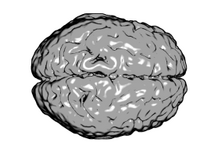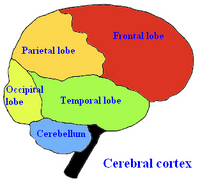No edit summary |
m (Cerebral hemisphere moved to Cerebral hemispheres over redirect) |
Revision as of 06:59, 9 April 2008
Assessment |
Biopsychology |
Comparative |
Cognitive |
Developmental |
Language |
Individual differences |
Personality |
Philosophy |
Social |
Methods |
Statistics |
Clinical |
Educational |
Industrial |
Professional items |
World psychology |
Biological: Behavioural genetics · Evolutionary psychology · Neuroanatomy · Neurochemistry · Neuroendocrinology · Neuroscience · Psychoneuroimmunology · Physiological Psychology · Psychopharmacology (Index, Outline)

The human brain as viewed from above, showing the cerebral hemispheres. The anterior aspect of the brain is to the right.
A cerebral hemisphere is defined as one of the two regions of the brain that are delineated by the body's median plane. The brain can thus be described as being divided into left and right cerebral hemispheres. Each of these hemispheres has an outer layer of grey matter called the cerebral cortex that is supported by an inner layer of white matter. The architecture, types of cells, types of neurotransmitters and receptor subtypes are all distributed among the two hemispheres in a markedly asymmetric fashion. However, it must be noted that, while some of these hemispheric distribution differences are consistent across human beings, or even across some species, many observable distribution differences vary from individual to individual within a given species.
Lobes

Lobes of the human brain viewed from the right side. The frontal lobe is demarcated in red, the parietal lobe in orange, the occipital lobe in yellow, and the temporal lobe in green.
Neurologists subdivide the cerebral cortex into the following four lobes:
- the frontal lobe - the most anterior (rostral) portion of the brain, toward the face
- the parietal lobe - immediately posterior to (behind) the frontal lobe
- the occipital lobe - the farthest posterior region, nearest the spine
- the temporal lobe - underneath (inferior to) the other cortices, the temporal lobe in humans sits near the "temples" of the face
Neurologists also recognize two additional areas of the cerebral cortex:
- the limbic system - including the cingulate cortex, located above the corpus callosum
- the insular cortex - buried within the lateral sulcus.
The hemispheres are linked by the corpus callosum, a very large bundle of nerve fibers, and also by other smaller commissures, including the anterior commissure, posterior commissure, and hippocampal commissure. These commissures transfer information between the two hemispheres to coordinate localized functions.
Hemisphere lateralization
- Main article: lateralization of brain function
Popular psychology has suggested that the right brain is responsible for creativity and emotion, and the left brain is responsible for logic, analysis, and spatial reasoning. However, these are broad generalizations with little support.
The best evidence of lateralization for one specific ability is language. Both of the major areas involved in language skills, Broca's area and Wernicke's area, are in the left hemisphere. Perceptual information from the eyes, ears, and rest of the body is sent to the opposite hemisphere, and motor information sent out to the body also comes from the opposite hemisphere (see also primary sensory areas).
If these specific pieces of the brain are injured or destroyed, their functions can sometimes be recovered by neighboring brain regions - even opposite hemispheres. This depends more on the age the damage happened than anything else.
The magnocellular pathway of the visual system sends more information to the right hemisphere, while the parvocellular pathway sends more information to the left hemisphere. There are higher levels of the neurotransmitter norepinephrine on the right and higher levels of dopamine on the left. There is more white-matter (longer axons) on right and more grey-matter (cell bodies) on the left (Carter, 2004).
Studying the brain has shown that simplistic pseudoscience claims about brain function tend to miss or skew vital information. It is important to stress that there is much about the brain that is not understood by scientists, but it is clear at this point that processes like creativity, emotion, spatial reasoning, and logical reasoning involve regions spread across the brain.
Researchers neuropsychologists like Roger Sperry have studied split-brain patients to better understand lateralization. Sperry has also used tachistoscope to present visual information to one hemisphere or the other. Scientists have also studied people born without a corpus callosum to determine specialization of brain hemispheres.
Reference
- The Emerging Mind; Vilayanur S. Ramachandran; Reith Lectures 2003.
- R. Carter, Mapping the Mind, Phoenix, London, 2004, Originally Weidenfeld and Nicolson, 1998.
- More information on these lobes can be found in a book by Dr. Eric Braverman "The Edge Effect."
See also
External links
es:Hemisferio cerebral fr:hémisphère cérébrale Template:EnWp